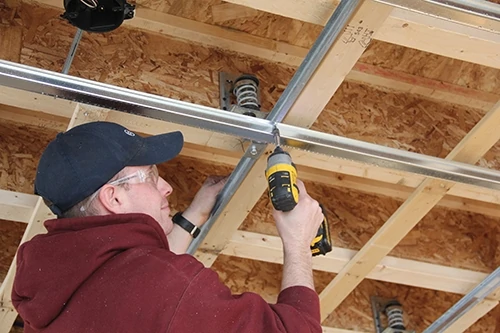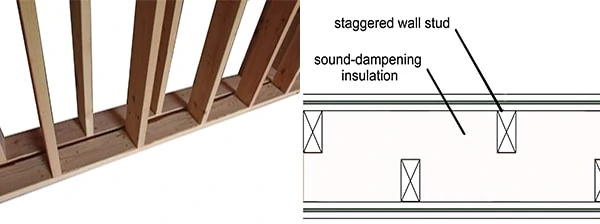What’s That Sound?
By Rob Robillard
When I think of soundproofing my mind immediately wanders to the Buffalo Springfield lyrics: “Stop children, what’s that sound, everybody look what’s goin’ down.” You can’t escape noise. It’s everywhere, both inside and outside the home, distracting you from work and disturbing your leisure.
While we can’t escape noise we can certainly muffle or reduce it. On a recent project a client asked us to install a ceiling and wall system using Kinetics Wood-Frame Ceiling Hanger (Model ICW), IsoMax Sound Isolation Clips, and resilient channel beneath the drywall.
This project intrigued me, so I reached out to a local sound proofing expert for some advice and background information. Here is what I learned.
Controlling Noise
The first step in soundproofing ceilings, interior walls and floors is identifying what your sound issues are and where they are coming from. Is noise bouncing around the room making it hard to hold a conversation? Is there an echo? Do downstairs neighbors complain about the noise you make?
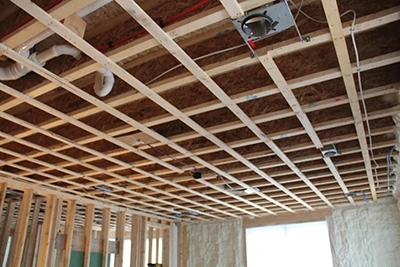
Controlling noise can be an active or passive means of reducing sound emissions, most people want to achieve this for personal enjoyment, whether it’s to reduce internal noise from a home theater, child’s TV room, a band rehearsal space or to reduce external environmental noise such as adjacent neighbors, traffic, train or airplane noises.
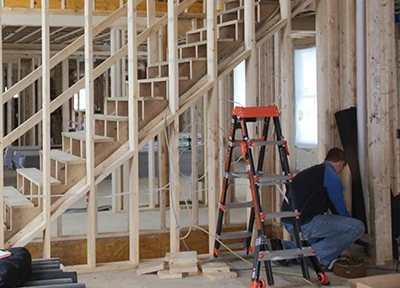
The first step in noise control is to identify the source of the noise. The best course is to reduce the noise as close to the source as possible. This is why many apartment or condominium complexes build fences around their units. Ever wonder why businesses put AC units up on roofs?
When dealing with loud air conditioning compressors, fans or other HVAC mechanical equipment, enclosing them often significantly reduces noise.
When thinking about reducing noise inside a home you need to reduce reverberation. Reverberation is the echo that sound creates as it bounces off surfaces in a room rather than being absorbed.
I’m not advocating bringing back the shag carpet, but it did help absorbs sound.
You can reduce reverberation by installing the following:
• Double- or triple-pane windows designed for noise reduction
• Acoustical wall and ceiling board
• Carpeting
• Additional insulation
• Commercially available coverings designed for noise control
• Double-wall framing
• Double layers of 5/8-in. drywall, seams sealed with silicone
• Commercially available vibration isolation systems, rubber sheets, panels and baffles
Four Basic Principles of Noise Control
If you want some peace and quiet in this noisy world, the best approach (besides moving to the country) is to understand four basic soundproofing principles:
• Mass
• Sound absorption
• Vibration dampening
• Mechanical decoupling
Mass
Mass impedes sound transmission—period. Materials such as brick, thick glass, concrete and metal all have high-density disrupting properties.
We followed the mass principle by increasing the thicknesses of our wallboard, adding mass, double layers of 5/8-in. thick drywall, to the walls and ceiling. A simple rule of thumb says that doubling the drywall layers will yield a 4-5dB reduction in the transmission of sound.
Sound Absorption
Adding insulation helps absorb the transmission of noise (rever-beration) and lowers the resonant frequency of decoupled walls by providing a mass barrier to soak up and disrupt the noise. Sound that transmits through the drywall on one side of a wall can be reduced by insulation absorbing some of its energy before reaching the opposite side. The insulation acts as a sound absorber, not a sound blocker.
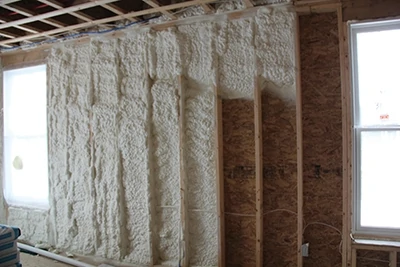
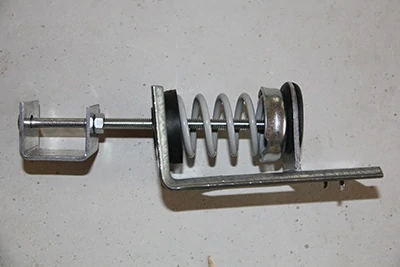
Sound absorbers reduce the reverberation time, as well as echoes. Sound absorption “sucks up” the noise like a sponge. Common sound-absorption materials include decoupled lead-based tiles, open cell foams, fiberglass insulation, “acoustical” insulation or recycled cotton insulation. Roxul Safe’N’Sound stone wool insulation is designed for soundproofing and has some of the best low and high frequency ratings (and is very cost-effective).
For the project shown, we used R13 batt insulation in the walls, and R19 in the ceiling.
Vibration Dampening
Vibration dampening refers to vibrating surfaces. A common material is sound-deadened steel or Mass Loaded Vinyl, which works great as a sound-transmission blocker on ductwork and plumbing pipes located in ceilings and walls.
Mass Loaded Vinyl is a dense PVC sheet, loaded with Barium Sulfate or Calcium Silicate to add weight. It’s a heavy product and weighs one pound per square foot, which it is effective at reducing airborne noise.
We used it to enclose all of the drainpipes in the ceiling and wall cavities.
Mechanical decoupling
Mechanical decoupling prevents transmission of vibration energy from a source to a receiver by introducing a flexible element or a physical break. Common mechanical decouplers are staggered wall studs, doubled wall studs, resilient channel, springs, cork etc. We often see these items on AC units and other types of HVAC mounted to rafters in residential buildings. Mechanical decouplers are also used in many types of household items on pumps, motors, HVAC systems, washing machines and high-end audio equipment.
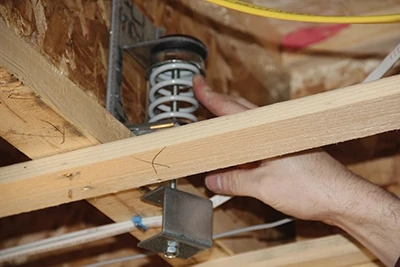
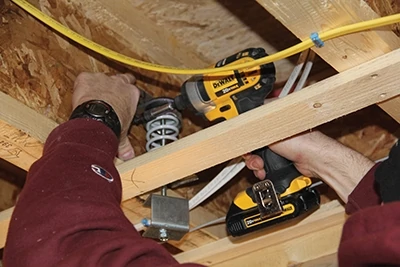
Using Vibration Isolation Systems
On this project the owner specified that we use a commercially available noise control system. We used resilient channels mounted with Kinetics wood-framed ceiling hangers [Model ICW] and IsoMax resilient sound isolation clips. This system separates the drywall from the studs, which helps eliminate vibrational noise and further reduces the sound transmitted through the walls.
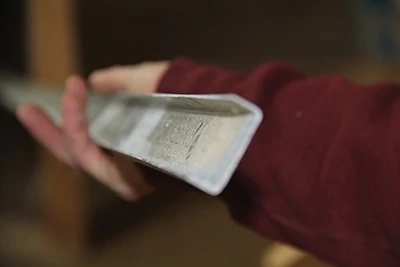
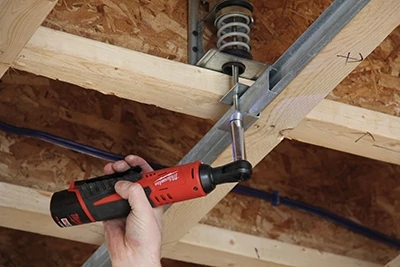
Ceiling System
The Kinetics ICW wood-frame ceiling hangers secure to wood-frame construction (e.g., joists, trusses), and have a one-inch deflection spring in series with a neoprene cup to resiliently support one or more layers of gypsum board. The bracket design allows the isolator to be installed on the joists to optimize ceiling height.
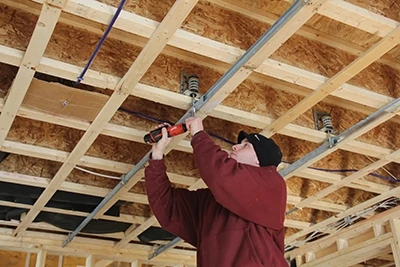
A channel clip and threaded leveling-rod assembly are designed to carry a single piece of 1-1/2-by-1/2-in. 16-gauge steel carrying channel. Drywall furring channel is then attached to the carrying channel 16 inches on center to take the place of ceiling board strapping.
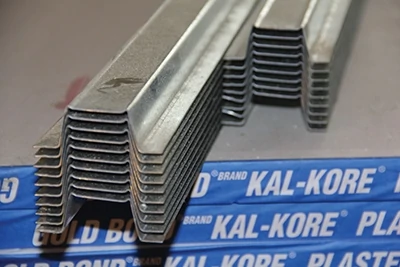
The end result is a ceiling that is isolated from the house frame, providing vibration isolation. On this installation several factors necessitated us to install the brackets and run our carrying channel perpendicular to the joists. Either direction will work with this ceiling system.
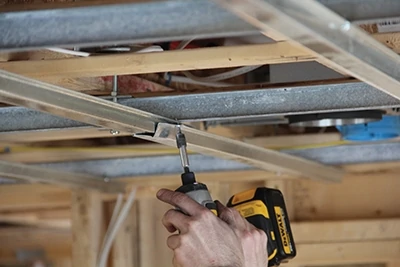
According to the manufacturer, the ICW ceiling with two layers of drywall plus 3-1/2-in. fiberglass batt allows a maximum natural frequency of 4.4 Hz under lightest typical load conditions. The reason for the 3-1/2 inch insulation is to create an air cavity. The air cavity helps increase sound isolation.
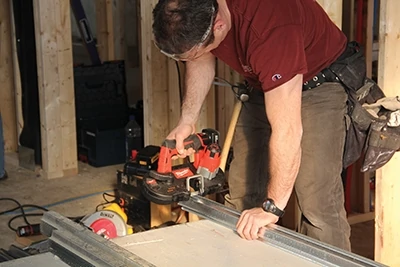
The ICW hangers can be installed 48 inches apart and no more than 16 inches from the perimeters of the room.
One or more layers of drywall can be hung from the furring channels using common construction practices.
Wall System
For soundproofing the walls, the IsoMax clips are designed to carry a resilient furring channel, commonly referred to as “Hat Track,” with one or more layers of drywall attached.
The installation of the IsoMax Sound Isolation Clips is easy and requires two screws each. They can be spaced a maximum of 48 inches and the furring channels spaced 24 inches apart. The top row should be maximum 6 inches to the center of the channel from the ceiling and the bottom row maximum 3 inches to the center of the channel from the floor.
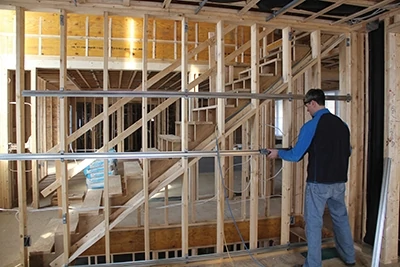
When using this system on walls, make sure the first layer of drywall seams align over the center-line of the horizontal furring channels.
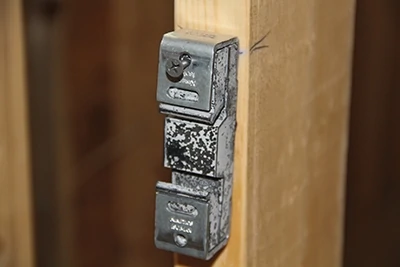
All potential sound leaks—gaps around outlets, window, or doorframes; pipe penetrations and the like—should be sealed with a non-hardening acoustical sealant or resilient putty.
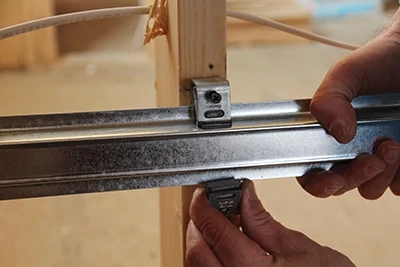
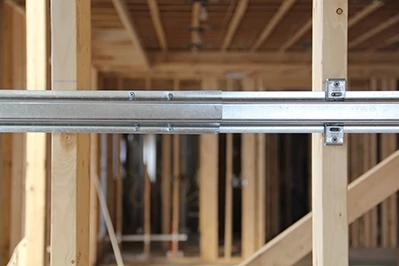
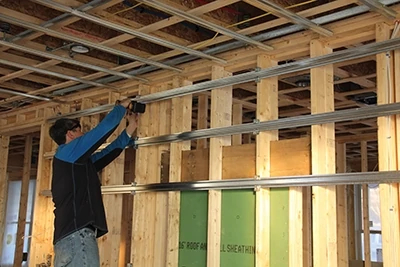
Doors and Vents
Doors, lights and HVAC vents are other ways sound will find its way in or out of your room and should be considered part of your plan. There are commercially available products for treating all three, such as insulated ducts, dead vents, special caulking, weather-stripped and insulated doors, air-lock double doors and recessed light backer boxes.
On this project the doors were the weak link; there were no soundproofing measures applied to them. The architect, however, designed these doors with an outer foyer that also had doors.
If the homeowner truly wants soundproofing they will need to close both sets of doors and add weather-stripping and sweeps.
Improvement “Sounds” Like a Plan
Soundproofing products often come with a Sound Transmission Class (STC) rating. STC is a measure of how many decibels of sound reduction a product provides. The higher the STC rating, the better.
A change of just 10 STC will result in a massive improvement.
Whatever you decide, attack noise using all four principles to reduce the transmission from inside and outside your home. After limiting or eliminating noise makers, utilize sound-absorbing materials and decoupling systems to lessen the effect of noise.
Side Note
Framing Walls for Noise Control
The walls and doors of our project house were already framed, but if I had my way I would have followed the “old school” method of soundproofing and constructed a staggered stud wall at the staircase and bathroom wall of this room. Staggered walls are basically two walls built very close together. Drywall is only attached to the outward-facing side of each set of studs, and high-performance soundproofing insulation is used to fill the void between them. This is more economical than actually building two walls, and achieves similar performance in a narrower profile.


